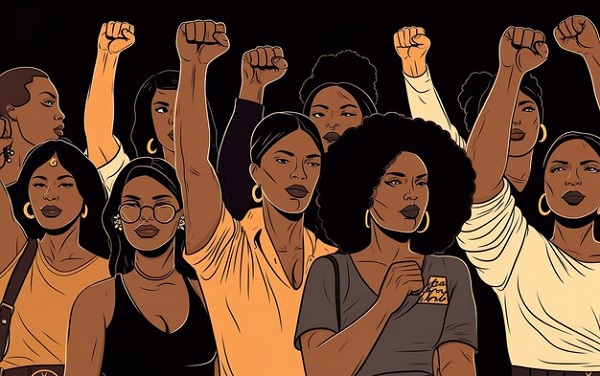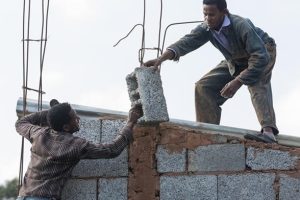
The concept of chameleon imagery was raised in the theory of Nego Feminism of Obioma Nneameka. The philosophy behind this theory is to alert African women to disguise the natural trait of chameleon in the African real context. The logical basement for this principle is the historical, political, religious and socio-cultural backgrounds and veracities of the continent.
As studies have been showing, Africa is featured by a patriarchal social system. Male takes the leading role at every space, and women subversion and silence is the accepted and expected trend in the society. With such validity, improving gender equality and portraying women agency needed to formulate a solution from the problem itself is the base of African feminists like the mentioned theoretician.
Nneameka advised African women, not men, to imitate the natural characteristic of the chameleon in a situation of their real society. The basic traits of the animal which are suggested to be adopted by the women are presented with personal experiences as demonstrative instances for each point.
The first trait of the animal that African women should copy is its nature of goal oriented-ness. The basic goal of the animal is to find food. In doing so, it first looks at the food, and then keeps moving to that food even though the path is full of thorns and discomforts. The life of African women is thorny, as far as the patriarchal trend is prevailing in the society with its somber extent. Thus, like the lizard, women should set their own target and move on to achieving it through the massive challenges they are apt to face.
Nneameka predicted how difficult it could be for African women to succeed in various facets. Thus, she needed them to be committed, very strong, optimistic and forecaster when moving to their target, of course in a manner aligned with their social, cultural and religious values. In addition to setting goals, as the chameleon does, the women’s attention should only be to get focused on their objective. Threats like thorns, storms, even comforts could distract women from their focus. But, as the scholar asserted, the women should predict possible barriers and be strong on their decision. In line with this principle I, as an academician and researcher, have some experiences of myself, in my studies and my interactions within my community.
When I joined Addis Ababa University for my first degree from my rural birth place, I was facing lots of unpredictable, unimaginative, and very new circumstances and challenges which were in a way to block my way to my target. As a countryside girl, eating in front of people was the first shocking move which sharpened its teeth to cut my line to my education. I was almost in a way to get back to my family. This was most of the girls’ problems which were like mine in origin and character. This happened for the reason that girls in my area were often made to eat the remaining food from the family away from their face, usually in the kitchen. I then realized that my family didn’t expect me to get back without holding my degree or regular break time. I then decided to consult with some senior female students’ experience so that I could draw my own way out. I took lessons and upgraded myself for future steps I should do.
There followed many more impressing and demoralizing situations during my stay in the campus. Financial problem was a very hindering factor and source of related challenges. Since the banking system was manual at that time, money transfer did take more than two months. Thus, it was difficult to get money to buy sanitation materials, learning instruments, making photocopies and others. But other girls were warring for their styles and fashions. More than my problem, this bigger difference between me and them was always making me nervous.
The other thorn in my way was the harassment of male and even female students and teachers at different extent. Moreover, friends and even family members were in a way to convince me to stop my education and get married as my friends in my village. It was challenging neither to convince nor ignore them. As a lizard passes through tough roads, the environment of the campus itself was horrifying to resist and to keep moving to my goal. But in a time of hopelessness, I drew how I could be fascinated when I receive my degree. Uh I have to pass it! This was my usual phrase.
The room that I was assigned was made deliberately. I was sharing it with those who were very stylish and naughty girls from well to do families. The dialect they applied, their body gesture, their dressing style and their makeup was very organized and attractive so that they were reproaching my style and making fun of it. These were my thorns that I and other girls from the same background had passed to achieve our target. Though this type of challenge was made by girls, I believed that it was impacted by the patriarchal perceptions of the society. Researchers can do on it for further justification.
The second trait of the lizard that women should duplicate is cautiousness. As the scientific evidences show, a chameleon is naturally very active in detecting its environment and designing schemes for problems it faces in its move without disturbing anything. Like the animal, African women should be conscious and alert for things that may happen in their surroundings.
In my first degree study, though I was from a rural area, I was always very active in the class, in my interaction with students and teachers and the environment. When worksheets and training on common courses like ‘logic’ were given by different senior students for freshman classes at different grouping systems, I was very active to get informed earlier than others. This had helped me to score good grades in my batch.
The third and the last point that Nneameka brashly advised us is the fastest adaptive skill of the animal. Chameleon is well known with the trait of changing its color as per the type and situation of the environment that it is crossing when heading to its food. Harsh and dangerous obstacles are obvious that for a smooth solution it disguises the problem itself so that it escapes its enemies strategically. This characteristic of the lizard is very vital for women of Africa where they are embedded by the patriarchic sociocultural reality.
In the course of any success at any aspect like education, politics, or business, women are obliged to face new habits, environments, living styles, cultures and norms. Though such things are capable of obstructing their move, being active and strategic to adapt the situation is the best solution as Nneameka believed in her theory.
This is the peaceful solution which relies on the efficacy of the woman rather than the man. I can infer the major character Tambu from Tsitsi Dangarmbga’s novel called ‘Nervous Condition’. Tambu was the smart character in approaching her environment strategically. She was in her uncle’s house for education. The way of life, their style, their treatment and others were very new to her. But she was active and optimist to adapt to their life. Thus, she got her education and succeeded in it.
Most successful girls who are from different areas, culture, religion, economic background and philosophy are smart in identifying, assimilating and compromising their own value in the context that they are through. As I mentioned, in my campus life, the things I faced were very new and beyond my expectation. But since I had a goal, I convinced myself to learn how to live there tactically. Since I was good in my education, I started helping naughty girls who were abusing me by creating fun in my dialect. I showed them how good I was in my studies. Then instead of hurting my emotion, they started begging me to help them in their studies. That way I started learning to reconstruct my language style. I mostly use English to escape my dialectic problem. With these methods, I adapt the way of communication. Regarding the meal, I was taking it away for some months, and then I adapted to it slowly.
These all challenges did emanate from the sociocultural appraisal of male supremacy. Thus, to boost development and transform the continent, the half section of the society should get equal recognition and spaces in various aspects. It is obvious that the deep-rooted patriarchal system could not be combated and avoided per night. It needs time and transformation of the culture and social construction. Thus, this is possible to move through it strategically and achieve goals massively then attitudinal change on gender could naturally follow.
BY MEKDES TAYE (PhD)
THE ETHIOPIAN HERALD SATURDAY 25 MAY 2024





